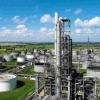Good Afternoon,
I found this forum really interesting. I work for a marine classification society and was reviewing atmospheric condenser with steam being supplied at 659 Kcal/kg and condensate at 75 deg C. Cooling sea water in entering at 36 deg C and leaving at 58 deg C. In my opinion, there should be a relief valve on the tube side of the condenser so that in the event of isolation, the tube side is protected from overpressure due to vaporisation of water from steam. I would like to calculate how much vapour will be genrated and how much would be rise in pressure in case there is no water inflow and steam is being continuously dumped inside the condenser. The steam is at 7.5 bars and water is at 5 bars. The discharge rate for steam is 3000 KG/hr and for water is 80 cubic meter per hour. Could you please guide me as to how I can estimate rise in pressure and whether a relief valve in tube side is required or not.
Thanks and Regards,
Varun
|
|
Pressure Relief For Tube Side In Atmospheric Condenser
Started by , Jul 18 2007 03:35 AM
2 replies to this topic
Share this topic:
#1

Posted 18 July 2007 - 03:35 AM
#2

Posted 18 July 2007 - 05:34 AM
Varun,
Your question is quite common and on this message board, we've discussed this topic in detail before. Yes, you are correct in that the pressure increase will be huge as the temperature of the blocked-in water increases. So as you logically determined, it would be a good idea to protect the exchanger tubes (you were not specific but the assumption is the water is on the tube side). The real good news is that you do not have to go through the calculation. As the liquid is heated, it will overpressure the tubes, simple and plain. In your application, finding out how much pressure will be nothing more than an academic exercise. I would typically specify a 3/4" x 1" PSV and be done with it. Some people use a 1/2" x 1" PSV. In either case, the capacity of these PSVs are significanly greater than what will be needed. And, because of this concept, in the U.S. OSHA doesn't even require you to show the calculation to justify its use!
If you still want to go through the academic exercise, API Standard 521 will guide you through the calculations. Also, since we've discussed this topic in detail before you can do a search on this site for "Thermal Relief" and see the previous discussions. By the way, the very previous post to yours was about a similar issue. You might want to have a look at it.
If you need any more help, don't hesitate to post your questions.
Your question is quite common and on this message board, we've discussed this topic in detail before. Yes, you are correct in that the pressure increase will be huge as the temperature of the blocked-in water increases. So as you logically determined, it would be a good idea to protect the exchanger tubes (you were not specific but the assumption is the water is on the tube side). The real good news is that you do not have to go through the calculation. As the liquid is heated, it will overpressure the tubes, simple and plain. In your application, finding out how much pressure will be nothing more than an academic exercise. I would typically specify a 3/4" x 1" PSV and be done with it. Some people use a 1/2" x 1" PSV. In either case, the capacity of these PSVs are significanly greater than what will be needed. And, because of this concept, in the U.S. OSHA doesn't even require you to show the calculation to justify its use!
If you still want to go through the academic exercise, API Standard 521 will guide you through the calculations. Also, since we've discussed this topic in detail before you can do a search on this site for "Thermal Relief" and see the previous discussions. By the way, the very previous post to yours was about a similar issue. You might want to have a look at it.
If you need any more help, don't hesitate to post your questions.
#3

Posted 20 July 2007 - 02:30 AM
Phil,
Thanks for answering my query. You assumed correctly that the water was on tube side. I agree that the calculation is not required in this case. However, vendor is not agreeing with my comment and hence I have to prove my point by doing some calculations. I do not have access to API STd. 521. If you can, please suggest some alternative to be used for calculation. I will look for other topics on relief valves in the mean time.
Thanks a ton !
Cheers !
Varun
Thanks for answering my query. You assumed correctly that the water was on tube side. I agree that the calculation is not required in this case. However, vendor is not agreeing with my comment and hence I have to prove my point by doing some calculations. I do not have access to API STd. 521. If you can, please suggest some alternative to be used for calculation. I will look for other topics on relief valves in the mean time.
Thanks a ton !
Cheers !
Varun
Similar Topics
Recommended Installation Location For "pressure High" InterlocStarted by Guest_omupei_* , 20 Jun 2025 |
|

|
||
Parallel Control Valves Downstream Relief ScenarioStarted by Guest_pklavinsJ_* , 18 Jun 2025 |
|

|
||
Distillation Tower Top And Bottom Temperature And PressureStarted by Guest_student55_* , 27 Mar 2016 |
|
|
||
Steam Sparger In Atmospheric Water TankStarted by Guest_owe_* , 16 May 2025 |
|

|
||
Steam Pressure In Heat ExchangerStarted by Guest_mvanrijnbach_* , 15 Apr 2025 |
|

|

 FB
FB







